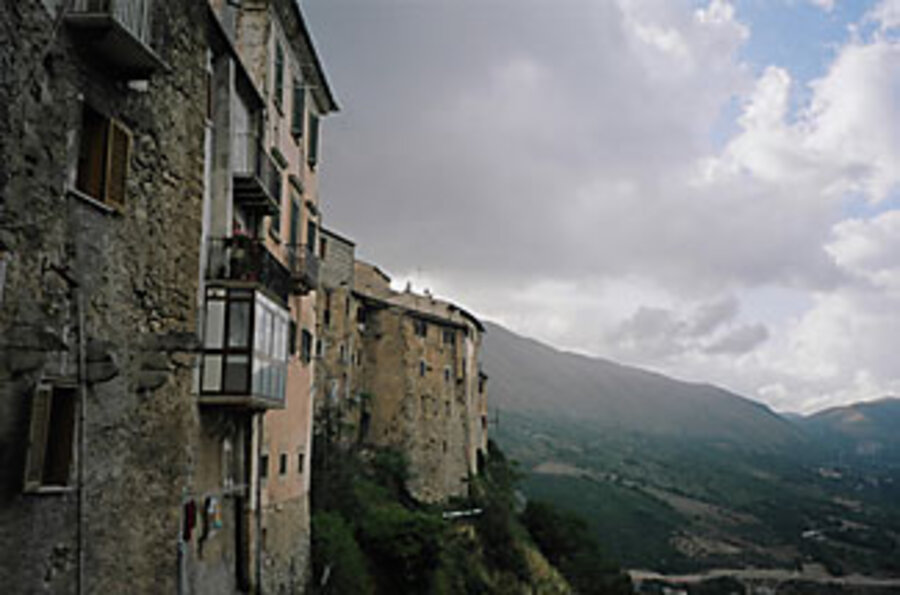A step into the world of Escher
Loading...
Watching from the back seat as our car slithered up a road so narrow it lacked a dividing line, I ducked down to get a glimpse of the row of medieval buildings teetering in the corner of my window.
We swung around two more curves and entered the village of Castrovalva, a community of about 300 in summer, 20 year-round. I had come to see a special exhibit about Dutch artist M.C. Escher organized by a young, local couple. It turned out that the isolated hamlet was the subject of one of Escher's most notable landscape lithographs called "Castrovalva," which now hangs in the National Gallery of Art in Washington, D.C.
Katia Di Simone and Piero Moscone had managed to suss out the details of the famous artist's travels nearly eight decades ago through this rugged swath of central Italy called Abruzzo. Culture Tracks, their tiny nonprofit, was putting on a miniversion of a previous exhibit held elsewhere in the region for the elderly residents of Castrovalva who hadn't been able to make the trek down the mountain to attend.
The show wouldn't start for another half hour, so I decided to wander a bit. Tracing back along the main road that dead-ended among the narrow alleys of the village, I met an elegant, elderly woman out strolling. Curious to meet locals, though embarrassed of my foreigner's Italian, I played it safe and simply smiled at her in greeting.
"Buona sera," she said warmly.
"Buona sera," I parroted back, gaining some courage in the process. Then I took a chance and ventured, "Are you from here?"
"No, no. I'm from Rome," she said, pushing designer sunglasses back over her head of white hair. "But my husband was born and raised here."
Seeing my eyes widen with interest, she introduced herself as Laura and proceeded to take my right arm in both of hers. "Have you seen the view?" she asked, in slow, deliberate Italian.
I shook my head, no.
"Venga," she said, using the polite command, "Please, come."
She led me by the elbow toward a spot at the edge of town that overlooked the forested valley. Positioning me in front of her, she pointed at the narrow line of buildings comprising the village that stretched away from us – the same row of homes I had seen earlier from below.
"See that tower?" she asked, extending a slim index finger into my line of vision, indicating the building nearest us. "That's the tower in Escher's lithograph."
I gazed for a few moments in stunned silence. How strange to be standing in such an out-of-the-way spot and discover that I wasn't the first foreigner to be inspired by this view. "Venga," she repeated, cordially. "I want to show you something else."
Regrasping my elbow like a bosom friend, she led me to the base of the tower we had seen from a distance. Laura unlocked the door and stepped inside. "Prego," she said, prompting me to follow.
We entered the cool, quiet building and made our way up a stone staircase. At the second landing, we came to an arched, wooden door. Laura removed a tiny padlock, and we continued up a narrower flight of stairs at the end of which we entered the top of the tower.
The roof soared more than 30 feet overhead. Afternoon shadows flickered over white walls. As my eyes adjusted, hundreds of square, gray cubbyholes – each the size of a brick end – honeycombed the walls from floor to ceiling.
It was a pigeon coop! Or, at least it had been one decades ago. The bird niches cast zigzagging, checkerboard patterns against the white background, and I twirled in place, trying to take it all in. I imagined the cavernous space filled with rustling wings.
Suddenly, it dawned on me how similar this was to the motif I had seen on countless coffee mugs, T-shirts, and math-department posters: a flock of black-and-white birds crisscrossing in repeating multiples across a make-believe sky.
"Escher's birds," I began, my mouth hanging open in amazement.
Laura nodded and smiled. After Escher had sketched Castrovalva for his future lithograph, he had entered the town and asked permission from Ercole Gianmichele – Laura's father-in-law, from whom she and her husband had inherited this tower – to come see the interior of the building he had rendered from afar. Once inside, according to family oral history, the artist was mesmerized by the checkerboard pattern of dark niches against white walls. Escher gazed for a long time, making a few sketches and taking photos. He even asked if he could return later on to observe it further.
But the young artist never made it back to Castrovalva. In the wake of Italian fascism some years later, Escher left the country with his wife, and Laura's father-in-law never heard from him again. But judging from his future works, particularly the "Metamorphosis" series, the patterns Escher saw in that tower-top pigeon coop remained etched in his memory for decades.
Like Escher, I had arrived in this out-of-the-way village with one intention and ended up discovering something entirely unexpected that will stay with me forever. It's strange and wonderful how it is often these serendipitous encounters that touch us most deeply and hover in our hearts, long after the journey home.





